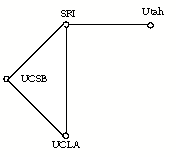Chapter 4 - Networking: Vision and Packet Switching 1959 - 1968
4.8 The RFQ and Bidding: 1968
After the Gatlinburg conference, Roberts began writing the Request for Quotation (RFQ), the document prospective contractors would use to bid building the network. He also began devoting more time to selling the network to ARPA contractors, all of whom were stretched thin for resources and were disinclined to reallocate ten to fifteen percent of their budgets to a network project, especially since it would give others access to their coveted computer(s). For those sites not willing to cooperate, Roberts held the ultimate source of persuasion and was willing to exercise his power if needed. He remembers:
So we just convinced them all they weren’t going to get any computer funding anymore unless they cooperated.
Not everyone needed to be convinced of a network’s potential benefits. In an article published in Science & Technology in April 1968, Licklider and Taylor wrote of a future day “when people of similar interests will work with each other through a network of computers – even when they are in the same room.”23 Later in the article, they predicted: “What will on-line interactive communities be like? In most fields they will consist of geographically separated members, sometimes grouped in small clusters and sometimes working individually. They will be communities not of common location, but of common interest. In each field, the overall community of interest will be large enough to support a comprehensive system of field-oriented programs and data.”
That might be a vision of the future, but the challenges of the present were much more modest. When distributed in July 1968, the Request for Quotation (RFQ) specified a four-node network with the potential to be expanded to 35 sites. The first nodes would be UCLA, SRI, UCSB and the University of Utah. UCLA would be installed in September 1969 with successive sites to be added monthly. (See Diagram 2.3 Initial Arpanet.) The minicomputer-based IMP’s were to be interconnected by 50 kilobit/second leased lines. The network transport mechanism was to be packets, but the IMPs would communicate with the Host computers using messages. Messages could be roughly eight times the size of a packet; hence, an average message would be parsed into eight packets. The RFQ outlined what the network was supposed to do, both structurally and functionally, without specifying how to do it. It would be the responsibility of the winning contractor to mold the concepts in the RFQ into a working system. Clearly it was hoped that some of the uncertainty of the design would be clarified in the responses to the RFQ.
Diagram 4.8.0 Initial Arpanet

Twelve firms responded to the RFQ. IBM, the largest computer company, did not respond, despite Licklider’s past evangelizing. Neither did AT&T bid. Four contenders held supplementary technical briefings and final negotiations were conducted between two finalists: Raytheon, and Bolt Beranek and Newman (BBN).24